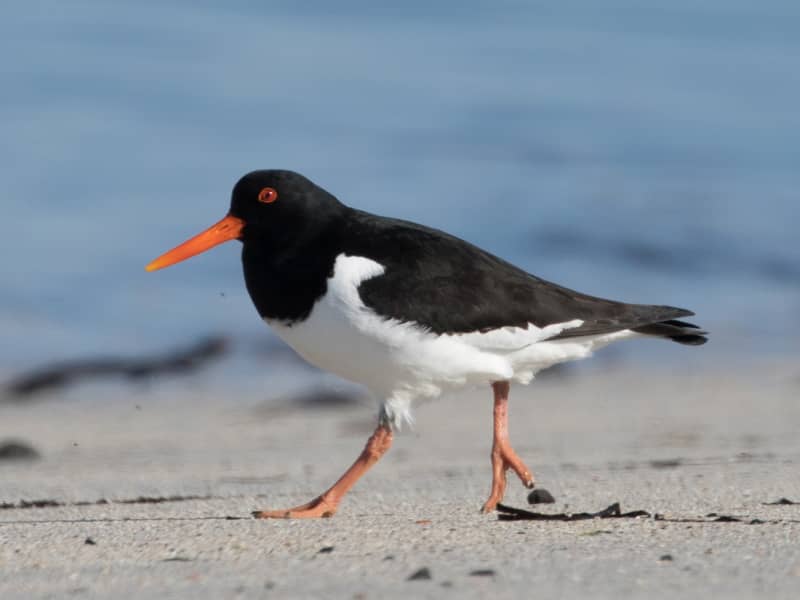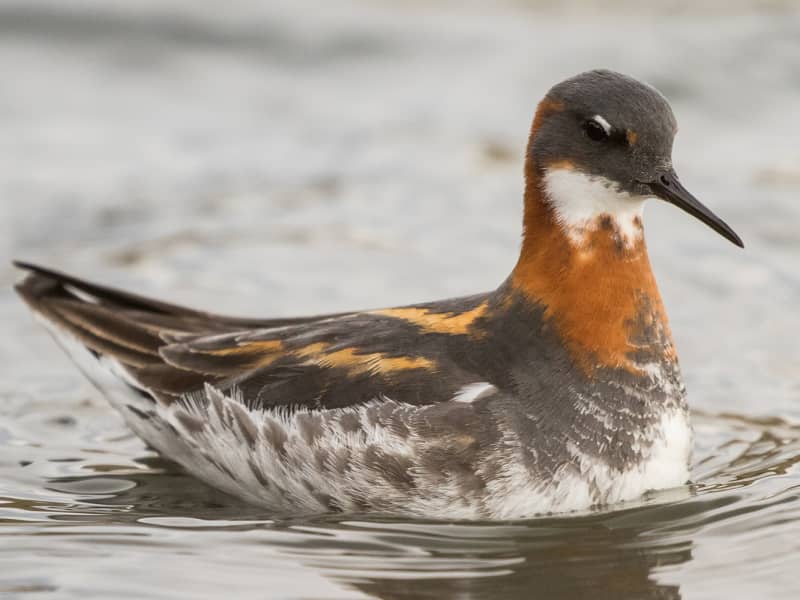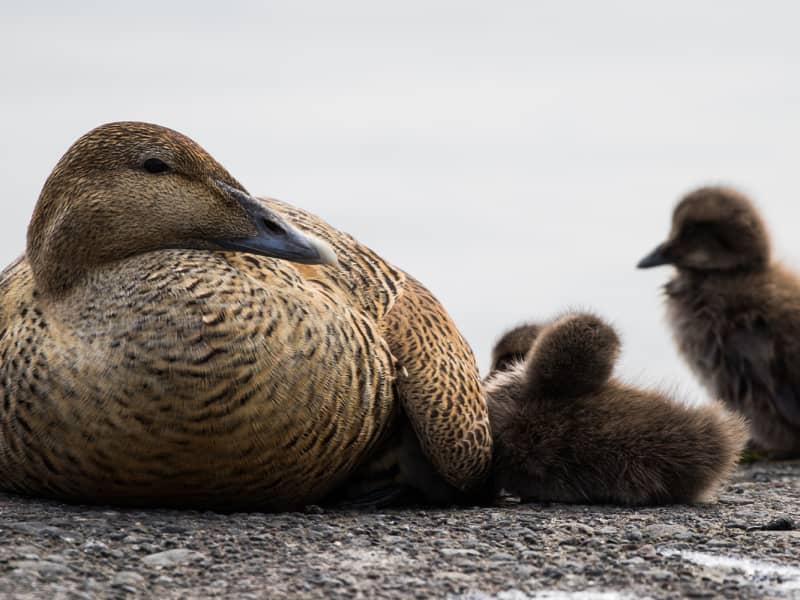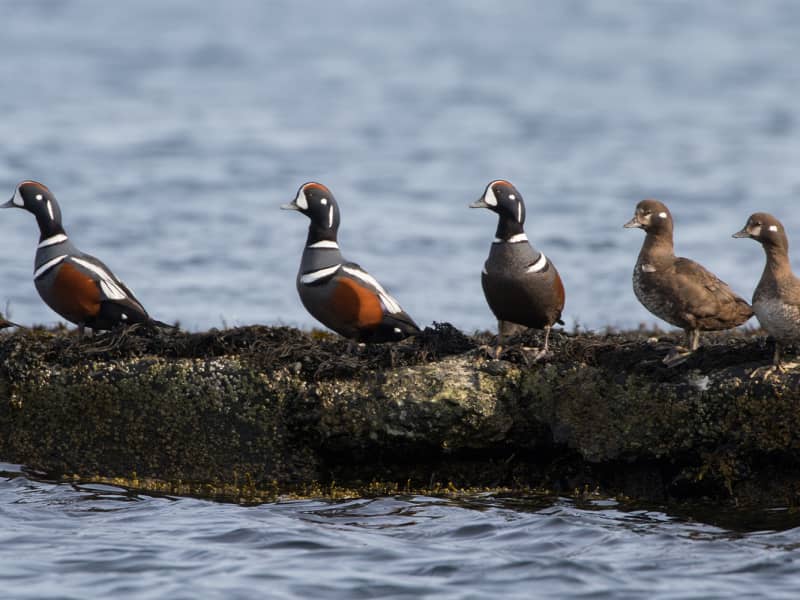Garður - Kalmanstjörn - Birding trails
Garður - Kalmanstjörn
Garður
Travelling from Keflavík to the tip of the peninsula one can see Snow Buntings (Plectrophenax nivalis), Rock Ptarmigan (Lagopus muta), young Gyrfalcons (Falco rusticolus) and Merlins (Falco columbarius). About 10 km north of Reykjanesbær is a town named Garður. Garður has one of the best vagrant ponds on the peninsula. Birds coming from the Atlantic often stop on these ponds for a rest. Many good species have been seen there, for example Gull-billed Tern (Gelochelidon nilotica), American Bittern (Botaurus lentiginosus), Purple Gallinule (Porphyrio martinicus), and many others. There are three ponds in Garður: Útskálasíki, Miðhúsasíki, and Gerðasíki. It is possible to walk around the ponds or even drive (4x4). Útskálasíki usually has the smallest diversity but the grass and fields around the pond are worth checking. Miðhúsasíki often offers close look at waders, sitting gulls and ducks, best seen when located at the houses on the southwest side. Gerðasíki can be scoped from the town’s swimming pool and from the road on the northeast part of the pond. Looking at the sea from spring to autumn can produce flocks of Manx Shearwater (Puffinus puffinus), occasional European Storm Petrel (Hydrobates pelagicus), skuas (Stercorarius sp.), Atlantic Puffins (Fratercula arctica), and other seabirds.
Garðskagaviti
The northernmost part of the peninsula has two lighthouses where you can find public toilets. The area around the lighthouses at Garðskagi is a known migration route and birds flock in from the highlands, and from Greenland and Canada. Seabirds fly close to shore on their way to the feeding grounds in Faxaflói. Scanning the sea to the north can be good for whale watching and seabird watching. The area is ideal for passing migrants as well as for rare vagrants. Lapland Longspurs (Calcarius lapponicus) are seen annually, wintering eiders, other sea ducks, and Great Northern Divers are found feeding on fish and mollusks close to land. Dogs are not allowed to walk free in the area. One of the best ways to find rarities in the area is to walk the landfill from the fish factory in Garður all the way to the lighthouse at Garðskagi. It is a good, paved path with birds on both sides!
Ásgarður
There is a gravel road close to Garðskagaviti which runs south. That road goes next to a farm called Ásgarður. On fields close to Ásgarður one can see huge flocks of European Golden Plovers in October. Annually there are American Golden Plovers (Pluvialis dominica) mixed in the groups with occasional Buff-breasted Sandpiper (Tryngites subruficollis). In summer these fields have breeding Meadow Pipits, plovers, Whimbrels, Eurasian Oystercatchers (Haematopus ostralegus), Arctic Terns, and Lesser Black-backed Gulls (Larus fuscus).
Garðskagaviti – Sandgerði Coast
The coast from Garðskagaviti to Sandgerði is a well-known area for bird watchers. Unfortunately, there are many private areas there but the golf course at Hafurbjarnarstaðir and Þóroddsstaðir/Nátthagi is placed next to a large pond with good places for spotting scope and walking the shore. Have a lookout for Rock Ptarmigans in the lava field and in the grass/snow in this area, especially east of Sandgerði and around the road close to Hafurbjarnarstaðir. There are ponds in many places near the shore on private land (Flankastaðir and Klöpp) so again, it is good to walk the shoreline.
Sandgerði
When you enter Sandgerði coming from Garður you will see a small pond on the right, a large pond on the left and a shallow pond a bit farther on the left. There are many breeding ducks in the larger pond over the summertime, and gulls clean themselves in this freshwater pond all year round. Don’t skip the small ponds, there is always a good chance of a vagrant. In recent years there have been Lesser Yellowlegs (Tringa flavipes), Green Sandpiper (Tringa ochropus), Cackling Goose (Branta hutchinsii) and Bonaparte’s Gull (Chroicocephalus philadelphia) on the small ponds. There is a hide at the side of the big pond but we don´t recommend it as it is badly located, chances are high that you have flushed all the birds away before entering the hide. After passing the small pond on the right, take the small gravel road next to the old fish factory and drive or walk to the edge of the sea. Pipes running from the fish factories wash pieces of fish to the beaches which gulls, worms and waders feed on. These are famous stopover sites for Sanderlings (Calidris alba), Dunlins (Calidris alpina), Ringed Plovers, Golden Plovers, Turnstones (Arenaria interpres) and other waders. Please be on the lookout for color-ringed Sanderlings and Oystercatchers, probably ringed in the Sudurnes Science and Learning Center. The pipe is a great attraction for gulls and fulmars and in winter there are always a few Blue Fulmars close to the pipe. Sandgerði is a big attraction for gulls, such as Lesser Black-backed Gull, Great Black-backed Gull (Larus marinus), Herring Gull (Larus argentatus), Glaucous Gull (Larus hyperboreus), Iceland Gull, Black-headed Gull (Chroicocephalus ridibundus), and Common Gull (Larus canus). One should always be on the lookout for vagrant gulls such as Little Gull (Hydrocoloeus minutus), Ring-billed Gull (Larus delawarensis), American Herring Gull (Larus smithsonianus), Ross’s Gull (Rhodostethia rosea), Ivory Gull (Pagophila eburnea), or Sabine’s Gull (Xema sabini).
The Sudurnes Science and Learning Center is located at Garðvegur 1 with toilets and great facilities for eating your own lunch. It is also a museum that offers two exciting exhibitions if you are interested in learning more about Icelandic nature and wildlife, both above and below sea level, as well as researches related to the areas.
Sandgerði harbour and mudflat is one of the most important places for migrating birds and breeding birds in the area. The mudflat can be looked at from many different points of view but under the chicken farm in the south part you can find dense groups of waders. Have your eyes open for Gyrfalcons and Merlins hunting near the shore. Entering the mudflat on motor vehicles is forbidden.
South of the mudflat is a rocky shore. On that shore we have one of the few spots of wintering Eurasian Curlew (Numenius arquata). No one knows were the birds breed but there are about 5-15 birds seen every winter in this area. Total number of Curlews in the wintertime in Iceland is around 40-70, with very few records of breeding Curlews. South of the rocky shore is a long sandy beach which carries large numbers of waders.
Norðurkot
After driving past the harbour area along Stafnesvegur-road to the south you can see many ponds on the way that you should scope carefully. The best ones are at the Norðurkot area. This is the biggest eider colony on the peninsula, and here the farmers collect down for export. It is closed during the breeding time, except the paved road itself. You should never drive fast through there in summertime because there is an Arctic tern colony close to the road and the birds use the road as a sitting area. The area is watched 24 hours a day during the breeding season and the area is fenced off with nets. Intruders, such as foxes, minks, and gulls that enter the area are shot.
Hvalsnes
Going further south you will eventually see a beautiful stone church of Hvalsnes, where you can park and walk the area. By the sea you will find a small sandy inlet, a good location to spot waders. Between Hvalsnes and Hafnir is a farm called Stafnes which has a parking lot with a short walk to a lighthouse. Shoreline and seabird watching is worth a try in summer and autumn. Close to the lighthouse you can find plunging Northern Gannets (Morus bassanus) and birds going to feeding grounds close to land.
Ósar and Hafnir
Ósar is a small shallow bay close to the village of Hafnir. Ósar has a large sandy mudflat that is exposed on low tide. In the bay you can find all the wader species, and big flocks of ducks are seen both in autumn and winter. Winter counts in the area have around 5-10 Great Northern Divers, hundreds of ducks, such as Long-tailed Ducks (Clangula hyemalis), Mallards, Harlequin Ducks, Greater Scaup (Aythya marila), and Red-breasted Merganser (Mergus serrator), but mainly Common Eiders. Hafnir and Ósabotnar are a good place for wintering Gyrfalcon and Merlin. The Harlequin Duck is one of the most sought after species for visiting birders, as Iceland is its only European breeding ground. Harlequins winter at sea in areas where the sea is rough, and is rarely found on calm, sheltered waters. From late September to mid-April it can be seen at sea close to the harbour in Hafnir. The harbour in Hafnir has pictures of birds and some information about birds in the area. It is a perfect place to set up a scope and look at all the islands and skerries in the cove. Ósar and Hafnir are one of the best places in Iceland for birdwatching in the winter time. Great Skuas (Stercorarius skua) and Arctic Skuas (Stercorarius parasiticus) nest in the lava and short grass in the Hafnir area.
Kalmanstjörn
Kalmanstjörn is a small cove by a fish farm south of Junkaragerði. The runoff from the fish farm lures in ducks and gulls while big flocks of wintering Harlequins and divers/loons use the area for feeding during winter.
Hafnarberg
Hafnarberg is a bird cliff on the western part of the peninsula. Breeding birds there are Northern Fulmars, Black-legged Kittiwakes (Rissa tridacyla), Common Guillemot (Uria aalge), Brünnich's Guillemot (Uria lomvia), Razorbill (Alca torda), and Atlantic Puffin. There is a good parking lot with a bird sign at the start of the route. It takes about 20-30 minutes to walk down to the cliff and on the way you can see breeding Arctic Skuas.




